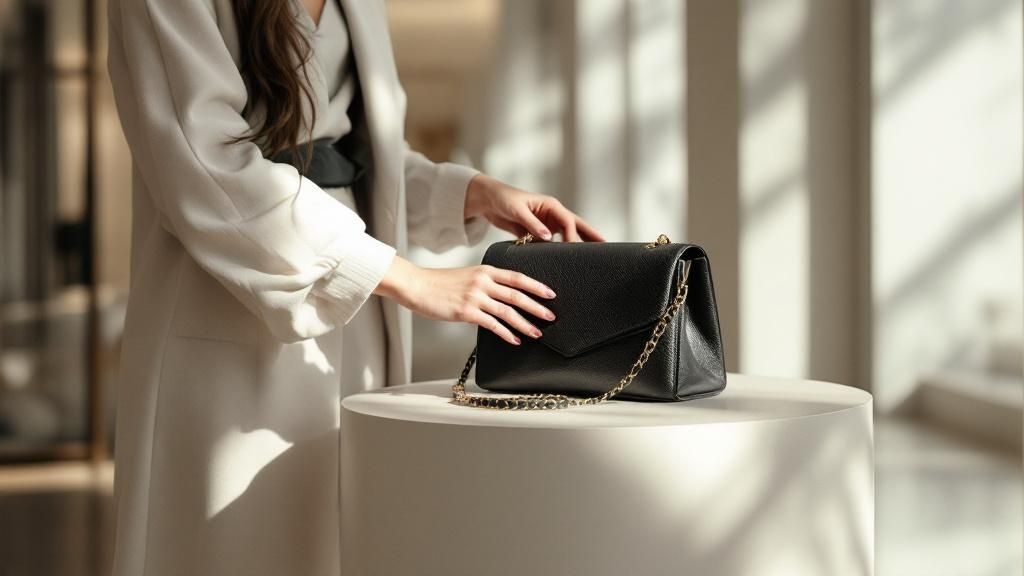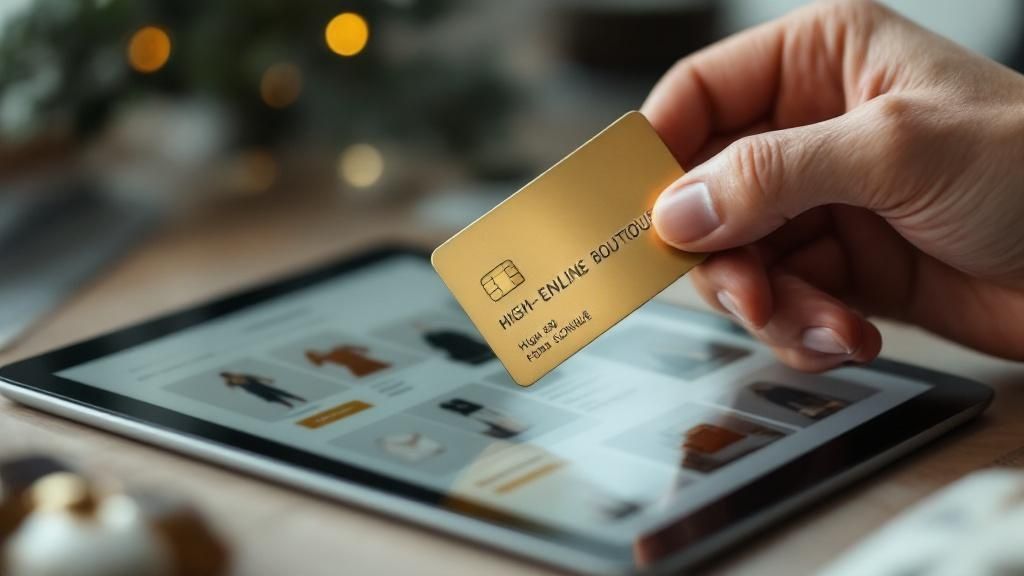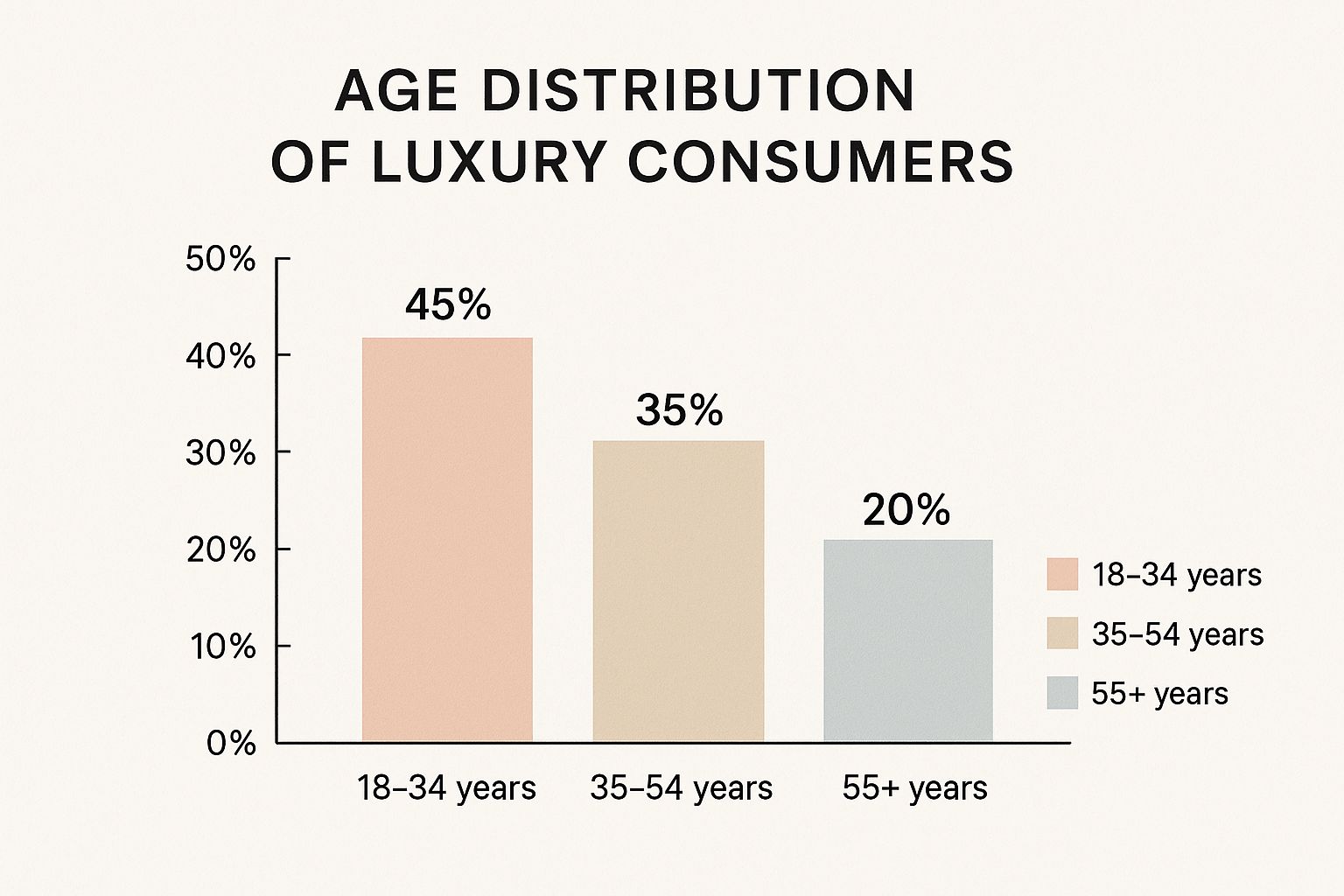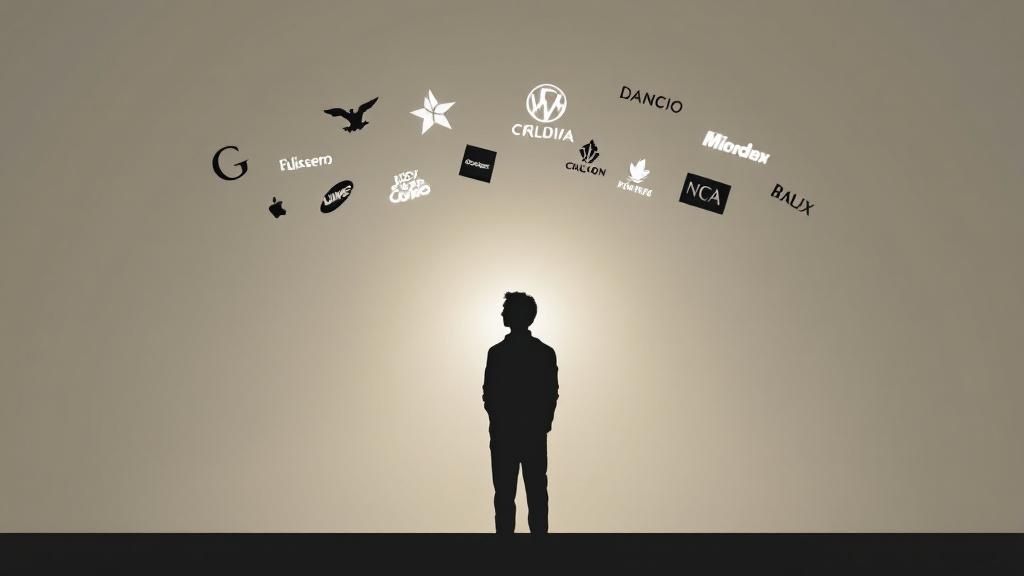Decoding The Luxury Mindset: Why Premium Purchases Feel Different
Think about the difference between buying a regular pen and a handcrafted Montblanc. They both perform the same basic function, but buying a Montblanc feels entirely different. It's a more significant experience. Luxury purchases go beyond simply fulfilling a need; they tap into a complex mix of desire, identity, and self-expression. It’s about how that purchase makes you feel.
This emotional connection is crucial to understanding why a $60 t-shirt and a $600 designer t-shirt trigger different reactions, even for people who can easily afford both. The pricier shirt isn't just clothing; it's a symbol, a statement, a piece of a personal story. It's not always about showing off wealth. It's often about rewarding yourself, celebrating a milestone, or expressing a carefully crafted personal brand.
The Psychology of Premium
Imagine you've worked hard, reached a big goal, and you're browsing a high-end store. A beautifully made handbag catches your eye. Buying it becomes a tangible reminder of your accomplishment, a physical representation of your effort. This is a powerful motivator.
For example, a study showed that 74% of UK consumers buy luxury goods primarily for their perceived quality. This reinforces the idea that luxury shoppers want more than just the product; they’re investing in lasting value and superb craftsmanship. This trend highlights how luxury brands can truly resonate with customers by emphasizing the enduring quality of their goods. The UK luxury goods market, valued at about $19.05 billion in 2025, is expected to grow steadily. However, even with this growth, 48% of UK consumers plan to reduce luxury spending due to economic conditions. This underscores how vital it is for brands to understand these changing spending patterns. Want to dive deeper into the UK luxury goods market? Discover more insights
More Than Just a Transaction
It’s important to remember that luxury consumer behavior isn’t fixed. It's always changing, shaped by cultural shifts and financial realities. The growing popularity of experiential luxury, for instance, shows how some affluent people are prioritizing unique experiences over material possessions. This changing landscape creates both exciting possibilities and new challenges for luxury brands.
The luxury market is experiencing a fascinating contradiction: as some consumers cut back, others are still captivated by high-end goods. This means luxury brands must carefully balance showcasing value while maintaining a sense of exclusivity. It’s about understanding that even in uncertain economic times, the emotions driving luxury purchases remain potent. This understanding is what differentiates brands that simply sell expensive things from those that genuinely connect with the luxury mindset.
The Great Luxury Shift: From Owning Things To Living Moments

Something interesting is happening in the world of luxury. It's a quiet revolution, a shift in values. For the affluent consumer, the focus is no longer solely on acquiring expensive things. It's about the experiences those things unlock. Think of it as a move from "What will people think?" to "What will I remember?" This signals a significant change in how we understand luxury.
Experiences Over Objects
Imagine you're given a choice: a brand new luxury car or a month-long, all-expenses-paid trip exploring the ancient ruins of Peru. Which excites you more? For a growing number of luxury buyers, it's the latter. This doesn’t mean the desire for beautiful, well-made objects has disappeared. The appeal of quality remains. But what "luxury" means is broadening. It now includes unique, personal experiences that create lasting memories.
For some, luxury is a bespoke culinary adventure. Think Michelin-star meals in far-off locations or private cooking classes with renowned chefs. Top Tasmania Food Experiences offers a glimpse into the kind of culinary journeys that are capturing the attention of this market.
The Rise of Conscious Luxury
This shift towards experiences also reflects a growing awareness of our impact on the world. Luxury consumers are increasingly seeking out brands that align with their values. Think ethical sourcing, environmental protection, and social responsibility. It’s about enjoying luxury without the guilt. This is particularly evident in the UK. A surprising 78% of UK consumers buy at least some of their luxury goods second-hand. Even more striking, 20% purchase over half of their luxury items pre-owned. This underscores a growing trend towards sustainable and budget-conscious luxury. Bespoke experiences are also on the rise in the UK. 36% of buyers are opting for uniquely tailored adventures like private jet travel or personalized culinary tours. This shows just how much the definition of luxury is changing. To delve deeper into the changing dynamics of the UK luxury market, check out this insightful article: UK Luxury Spending Trends.
Adapting to the New Luxury Landscape
This evolving consumer behavior presents both exciting possibilities and significant challenges for luxury brands. Companies stuck in traditional, product-focused marketing risk being left behind. Those who embrace experiential luxury, personalization, and responsible consumption are the ones set to thrive. This involves rethinking everything: marketing strategies, product development, and even customer relationships. It's about truly understanding what resonates with today’s luxury consumer. Increasingly, that’s the promise of a memorable moment, not just the possession of an expensive thing.
Meet Today's Luxury Consumers: Beyond The Stereotypes

Forget the old-fashioned idea of a luxury consumer. It's not just about inherited wealth and a certain age anymore. Today's luxury market is a vibrant mix of people with different backgrounds, motivations, and buying habits. Picture the young software developer diligently saving for a designer handbag, the entrepreneur carefully building a vintage watch collection, or the social media influencer who prioritizes high-end skincare. Luxury has diversified.
The New Faces of Luxury
This diverse picture shows a big change in how different generations see luxury. Younger consumers, in particular, often value authenticity and sustainability more than traditional status symbols. They want brands with a compelling story, a purpose that goes beyond profit. This focus on values connects to cultural influences, which shape the individual luxury preferences we see across various communities.
For example, young men in the UK are shaping the future of luxury. 22% of men aged 18-34 bought luxury items for themselves in the past year, mostly as a personal treat. This group is expected to spend even more on luxury goods in the future, reflecting a larger trend of younger consumers driving growth in the sector. Currently, 63% of them spend under £999.99 on luxury purchases, but their future plans hint at huge growth potential. In fact, the UK luxury market is expected to hit $28.56 billion by 2032, growing at a 5% CAGR from 2025 to 2032. Intrigued by this demographic? Discover more insights.
Beyond Age and Gender
The changing face of luxury isn't just about generational shifts. We're seeing more women becoming serious luxury collectors, changing traditional roles in the market. Diverse communities are also becoming increasingly important, shaping luxury culture in new and exciting ways. The combination of age, gender, and cultural background creates a rich mix of individual tastes.
The rising popularity of experiences, like luxury rail travel, shows how luxury is changing. People are looking for memorable, one-of-a-kind experiences, adding even more facets to the luxury world.
Understanding the Multifaceted Market
This deeper look into the evolving demographics of luxury provides important information for brands. Understanding these subtle differences is key to genuinely connecting with today's luxury consumer. It's about seeing the person behind each purchase and making the experience feel personal. This allows brands to go beyond broad stereotypes and engage with particular customer groups, building stronger, more meaningful connections. This focus on personalization is now essential for successful luxury marketing.
The Luxury Trigger Moments: When Desire Becomes Decision

The infographic above gives us a glimpse into the ages of luxury consumers. It shows that the 18-34 age group makes up 45% of the market, followed by 35-54-year-olds at 35%, and those 55 and older at 20%. This tells us something important: while luxury goods appeal across a spectrum of ages, younger consumers are a major force. Brands need to understand what makes these younger buyers tick.
There's a specific moment when simply admiring a luxury item morphs into actively wanting to own it. Think of these as trigger moments – the bridge between desire and purchase. Understanding these moments is crucial for anyone working with luxury brands.
Identifying the Catalysts
These triggers aren't random; they're tied to key events in a consumer's life. They're about emotions, aspirations, and marking special occasions with something tangible. Successful luxury brands are masters at pinpointing these moments and crafting marketing that truly resonates. Timing is everything in luxury. It’s about recognizing those subtle cues – emotional and social – that signal someone’s ready to buy something special.
For example, imagine a young professional landing their first big promotion. This is more than a pay raise; it's a validation of their hard work and a sign they're on the up and up. This moment might trigger the purchase of a top-notch suit or a fine watch – a tangible reward for their accomplishment. Luxury brands get this.
The Influence of Demographics
These trigger moments can be different depending on who you’re talking about. A younger consumer might buy a unique piece of clothing to express their individuality. An older consumer might be more focused on lasting quality and expert craftsmanship. Cultural background plays a part too. Some cultures put a higher value on certain luxury items, influencing what triggers a purchase.
A luxury car might be a status symbol in one culture, while curated travel experiences are more valued in another. Recognizing these differences is crucial for effective marketing. This lets brands personalize their message and create campaigns that really connect with different groups.
Let’s take a look at how these triggers might play out across different demographics:
Luxury Purchase Triggers by Consumer Segment
| Consumer Segment | Primary Trigger | Secondary Motivations | Average Purchase Consideration Time |
|---|---|---|---|
| Young Professionals (25-35) | Career Advancement (Promotion, New Job) | Social Recognition, Self-Reward | 2-4 Weeks |
| Established Professionals (35-55) | Financial Milestone (Bonus, Investment Return) | Quality, Craftsmanship, Legacy | 1-3 Months |
| High-Net-Worth Individuals (55+) | Significant Life Event (Anniversary, Retirement) | Enduring Value, Exclusivity, Personal Legacy | 3-6 Months+ |
| Millennials (25-40) | Social Media Influence, Unique Experiences | Self-Expression, Individuality, Brand Storytelling | 1-2 Weeks |
| Gen Z (18-24) | Personal Achievements, Social Impact | Sustainability, Ethical Sourcing, Brand Authenticity | Several Days to 2 Weeks |
This table highlights how different life stages and values influence luxury purchases. Younger consumers often decide more quickly, driven by social trends and personal expression, while older, wealthier individuals take longer, prioritizing lasting value and legacy.
Connecting at the Right Time
Connecting with consumers during these key decision-making moments is essential. This is where luxury brands can truly excel. By understanding the psychology behind these trigger moments, they can craft targeted campaigns that speak directly to the consumer's desires. This might involve personalized emails, engaging social media, or even exclusive events tailored to specific milestones.
It's not just about selling a product; it's about forging a connection and being present at the moments that truly matter. That's what separates successful luxury brands from the rest – the ability to connect on an emotional level and become part of their customers' stories.
Digital Luxury: Where Technology Meets Exclusivity

This screenshot from Net-a-Porter showcases a clean design, highlighting key luxury brands and collections. The high-quality imagery and personalized recommendations speak volumes. Net-a-Porter blends digital convenience with curated exclusivity, a crucial aspect of online luxury consumer behavior.
Luxury's relationship with the digital world has been an interesting one. Initially hesitant, brands have wrestled with maintaining their exclusive image online. How do you translate the personalized touch of a high-end boutique to the digital realm?
The Online Versus In-Store Paradox
Luxury consumers behave differently online. In-store, it’s about tangible interaction and service. Online, it’s research, reviews, and social proof. This difference is key. It’s not just about selling online, it's about creating a digital ecosystem that complements the in-store experience.
Imagine someone researching a luxury watch online, comparing prices and reading reviews, then buying it in a boutique. This highlights the need for a strong omnichannel strategy, blending the online and offline worlds.
Creating a Luxurious Digital Experience
Successful brands know replicating standard e-commerce won’t work for luxury. They’re crafting unique digital experiences that mirror the feeling of a flagship store. Think personalized digital consultations, exclusive online previews, and compelling digital storytelling.
Instead of just displaying products, they’re curating experiences. Think behind-the-scenes looks at the craftsmanship of a handbag or virtual styling sessions with experts.
Digital Storytelling and the Human Touch
Digital storytelling helps luxury brands connect with consumers emotionally, strengthening relationships. This might be showcasing a brand’s heritage through video or partnering with influencers who embody the brand's values. It's about enhancing personal relationships, not replacing them.
While technology is essential, the human element remains vital. Luxury consumers still value personalized attention. This could be a tailored email or a live chat with a product specialist. The best brands blend digital convenience with that personalized touch, reinforcing exclusivity and building loyalty.
The Psychology Behind The Purchase: Status, Identity, and Meaning
Let's explore the deeper reasons why people buy luxury items. It's more than just liking something or having the money. Purchasing luxury goods connects with our desires for identity, belonging, and expressing ourselves.
Think about it: a watch can represent professional achievement, a handbag might signal membership in a particular social group, and a car can reflect personal values. These items become more than just objects; they become symbols.
Luxury as Self-Expression
Luxury goods are like characters in our personal stories. They become part of how we define ourselves and project that image to the world. This explains why buying a luxury item feels less like a transaction and more like an investment in who we are.
Successful luxury brands understand this. They recognize the emotional weight of these purchases without resorting to manipulation. For example, someone buying a designer suit from Feinheit FZ LLC isn't just buying clothes. They're investing in an image of success and personal style. This feeling transcends the physical product and becomes intertwined with the wearer's self-image.
The Interplay of Achievement and Belonging
Luxury consumer behavior is a fascinating mix of personal accomplishments, social cues, and self-expression. Understanding this interplay is crucial. It explains why some luxury purchases resonate deeply while others don't.
Consider a watch, like those featured on TheFeinheit.com. One person might buy it to celebrate a promotion. Another might buy the same watch to join a community of watch collectors. Both motivations are valid and reflect different aspects of the luxury mindset.
Let's dive a little deeper into the psychological motivations at play, and how brands can address them. The table below breaks down these key drivers and their influence on purchasing decisions.
To understand how brands can truly connect with their audience, let's look closer at the psychology behind luxury spending. The following table details the key drivers and their strategic marketing implications.
| Psychological Driver | Description | Consumer Behaviour Impact | Brand Strategy Implications |
|---|---|---|---|
| Status | Desire for social recognition and admiration. | Drives purchases of highly visible, recognizable luxury goods. | Emphasize brand heritage, exclusivity, and craftsmanship. |
| Identity | Need to express one's self-concept and values. | Influences purchases that align with personal style and aspirations. | Offer personalized experiences, curated selections, and storytelling that resonates with target audiences. |
| Belonging | Drive to connect with a specific social group or community. | Motivates purchases that signal membership and shared values. | Create exclusive communities, events, and content that foster a sense of belonging. |
| Achievement | Desire to recognize personal accomplishments and milestones. | Triggers purchases that serve as rewards or symbols of success. | Align messaging with themes of success, ambition, and personal growth. |
| Meaning | Search for deeper purpose and significance in possessions. | Influences purchases that reflect individual values and beliefs. | Focus on brand storytelling, ethical sourcing, and sustainable practices. |
The table above illustrates how luxury brands can move beyond simply selling products and create meaningful connections with their customers. By understanding these drivers, brands can craft marketing strategies that resonate on a deeper, more personal level.
Finding Meaning in Luxury
Status is a factor, but it's not the whole story. Luxury purchases can be about marking personal milestones, rewarding hard work, or expressing a unique style. The key is understanding the "why" behind the purchase.
Imagine someone buying a luxury handbag. Is it because it's the latest trend or because it perfectly reflects their personal aesthetic? This nuanced understanding is what allows brands to connect authentically with their target audience. TheFeinheit.com, with its curated selection and focus on accessibility, speaks to this desire for authentic self-expression.
Building Authentic Connections
Brands that grasp the psychology of luxury purchases are better positioned to build genuine relationships with their customers. It's not just about selling; it's about being part of a shared journey of achievement, belonging, and self-discovery.
For example, Feinheit FZ LLC offers a 5% discount with codes LUXE5 or WELCOME10. This isn't merely a discount; it's a way of welcoming customers into a community. The free global shipping further enhances the luxury experience, making it effortless and accessible. Recognizing these psychological drivers builds a sense of community and shared values, ultimately fostering stronger customer relationships.
Turning Insights Into Action: Strategies That Actually Work
Understanding the luxury consumer is like peeling back the layers of a complex, fascinating onion. But all that knowledge is only as good as what you do with it. This section bridges the gap between consumer psychology and real-world business strategy, showing how luxury brands transform these insights into marketing that truly resonates. Even something as seemingly simple as scent can play a powerful role. Think about how the nuances of candle fragrance families can elevate a space and enhance the perception of luxury.
Aligning Strategies With Motivations
We'll dive into case studies of brands that have successfully aligned their strategies with what makes luxury consumers tick—everything from brand positioning and messaging to product development and the entire customer experience. We'll learn from both the triumphs and the missteps, exploring why authenticity and exclusivity remain vital in the luxury arena, even as consumer preferences shift.
Take Burberry, for example. Their successful integration of digital technology offers personalized experiences online, meeting the modern luxury consumer where they are. Then there's Rolex, a brand that maintains its prestige through carefully controlled distribution and storytelling that emphasizes heritage and craftsmanship. These examples highlight the power of understanding the luxury consumer's mindset and translating it into effective action.
Actionable Frameworks For Success
Through a step-by-step breakdown of successful campaigns and strategies, you’ll gain practical frameworks to apply these insights to your own luxury marketing puzzle. We’ll explore how to maintain that crucial luxury appeal while adapting to evolving consumer expectations, and why the most successful brands prioritize emotional connection over simply listing product features.
Consider the impact of offering exclusive pre-orders or personalized styling services. These tactics create a sense of exclusivity and personalized attention that luxury consumers crave. Similarly, highlighting a brand’s commitment to sustainability appeals to the growing number of luxury shoppers who prioritize ethical values. These concrete actions show how understanding customer values translates into effective marketing.
Emotional Connection Over Product Features
Thriving luxury brands understand that a purchase is more than just acquiring an object; it's about buying into a feeling, an experience. They focus on forging deep emotional connections with their customers.
Imagine purchasing a high-end watch. The emotional resonance isn't just about telling time; it’s the story behind the brand, the meticulous craftsmanship, and the feeling of owning a timeless piece. This emotional connection breeds loyalty and turns customers into passionate brand advocates.
From Insights To Measurable Results
This section provides practical strategies for turning insights into tangible results. It's about moving beyond abstract ideas and applying what we’ve learned to real-world marketing scenarios.
This includes monitoring crucial metrics like customer lifetime value, brand engagement on social media, and conversion rates for targeted campaigns. Tracking these indicators helps brands gauge the effectiveness of their strategies and constantly refine their approach. It’s a continuous cycle of learning and improvement.
Today's luxury brands understand that true luxury isn't just about the highest price tag. It's about crafting a compelling narrative, delivering exceptional quality, and fostering a sense of belonging.
Speaking of luxury, elevate your style with Feinheit FZ LLC's curated selection of premium fashion and accessories. Experience the difference between owning things and expressing your unique style. Discover top brands and enjoy free global shipping, plus a 5% discount with code LUXE5 or WELCOME10. Visit TheFeinheit.com today and redefine luxury for yourself.

